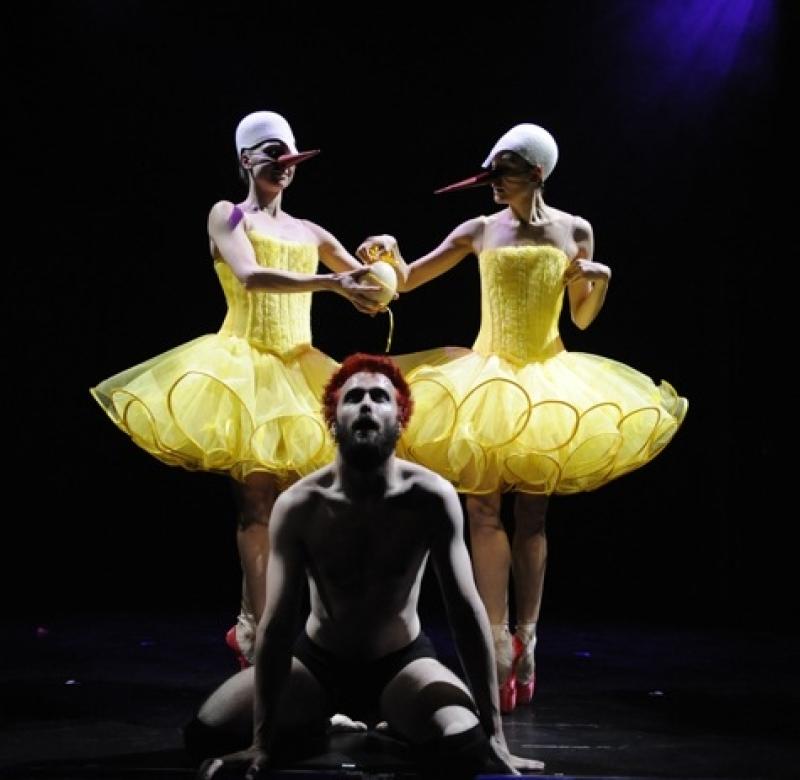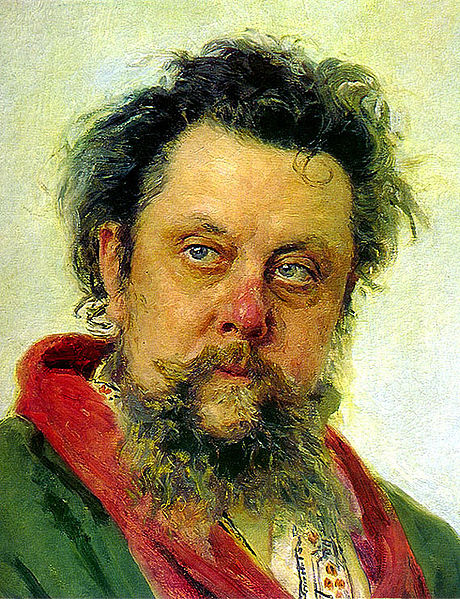Pictures from an Exhibition, Sadler's Wells | reviews, news & interviews
Pictures from an Exhibition, Sadler's Wells
Pictures from an Exhibition, Sadler's Wells
A lustily gory trip into the manias of a screwed-up composer

I’ve seen raping Popes, I’ve seen more naked guys dancing with waggling penises than I can count, I’ve seen naked breasts on dancing girls for what feels like all my adult life. But a man with a blood-stained prosthetic cock that looks like a baby’s bottle? A teacher munching a testicle off his pupil? Well, lor' love a duck.
Daniel Kramer’s florid, lurid production of Pictures from an Exhibition, a collaboration with the Young Vic last year, made it to its partner theatre, Sadler’s Wells, this weekend, a creation where theatre, music and dance elaborately combine in a lustily gory trip into the head of a gay, Oedipal, penis-fixated and manically alcoholic Russian composer.
Kramer’s productions alienate as many as they conquer (I thought his Duke Bluebeard’s Castle for ENO was as brilliant as others thought it crass) but Punch and Judy, Prick Up Your Ears and Prima Donna show his predilection for black humour, colourful modern allegory, childlike excess and yeurgh factor. This creation is a very free and liberal reinterpretation of Modest Musorgsky’s strange and formidably evocative piano suite Pictures from an Exhibition, composed in 1874, and another cross-media venture, being music about art.
Having a thoroughly heated imagination, Kramer has gleefully seized the modern route of the creator’s psychology, summoning up a car-crash of crises and neuroses in the real Musorgsky, and packing the hour like a Tardis with an infinitely expanding Freudian horror-version of Alice in Wonderland written up in Viz and possibly with passing nods to the Tiger Lillies’ Shockheaded Peter and Leaving Las Vegas. It’s like being stuck in an all-night bar with an insistent vodka addict, vomiting, ejaculating and pissing all over the place as he unburdens his appalling complexes. Meanwhile the music that he supposedly wrote is playing, wilfully deformed and recoloured to serve his flagrant stories, rather than in the form that he wrote them, which is about as pure and spare as something written in a monastery.
The exhibition of the title was staged posthumously for an artist, Viktor Hartman, who Kramer postulates was the object of Musorgsky’s tortured sexual longings. Five gigantic doors ring the stage, reminiscent of Alice’s size-shifting, or perhaps Bluebeard's den too; there is a vodka-vending machine that wittily plays a snatch of the Promenade section of the music, fantastical costumes of chickens, Russian soldiers and a near-naked witch, and tricks of light that seem to bring bones to life in the dark.
Men in top hats and greatcoats stalk through the nightmare, chased by stray shafts of light. Musorgsky - played by Chris New in a scarlet wig, few clothes and a state of drunken misery - cries out, “Viktor!”, and suddenly in a picture-frame high up in the wall appears a man who could be Hartman, or maybe Musorgsky’s father - at any rate a figure who reproves rather than approves. With designer and lighting man Richard Hudson and Peter Mumford, this is a let-it-all-hang-out staging of bravura absurdity and imagistic surprise.
 Chris New's narrative script is written by the poet James Fenton, which is less unpredictable. Indeed it must have been a terrible haunting that possessed Musorgsky, who really was a hopeless drunk and died aged only 42 (right, detail of Ilya Repin's portrait of him painted the week he died). But this is so pat. The lad has a cold mum, a distant dad and a quite naughty nanny who fiddles with the boy’s privates, then smacks him when he does the same. He recalls sexual sadism at school, the headmaster mutilating boys' genitals. One plaintive line recurs, about his sharing beds with other lads, discovering his separateness: "I have lived with men, I have slept with men, I have been one inch from love." The soldiers caper drunkenly through to a just-recognisable arrangement of the "Tuileries" number, in red jackets and huge bearskins hats, but almost naked underneath. Sex and soldiers, all muddled up, vodka bottles and penises all muddled up too.
Chris New's narrative script is written by the poet James Fenton, which is less unpredictable. Indeed it must have been a terrible haunting that possessed Musorgsky, who really was a hopeless drunk and died aged only 42 (right, detail of Ilya Repin's portrait of him painted the week he died). But this is so pat. The lad has a cold mum, a distant dad and a quite naughty nanny who fiddles with the boy’s privates, then smacks him when he does the same. He recalls sexual sadism at school, the headmaster mutilating boys' genitals. One plaintive line recurs, about his sharing beds with other lads, discovering his separateness: "I have lived with men, I have slept with men, I have been one inch from love." The soldiers caper drunkenly through to a just-recognisable arrangement of the "Tuileries" number, in red jackets and huge bearskins hats, but almost naked underneath. Sex and soldiers, all muddled up, vodka bottles and penises all muddled up too.
Maybe this is a boy thing. The work remains cock-centred much of the time, one black joke after another about the gay boy’s castration complex, evolving into the gay alcoholic man’s DTs. Bums, vomit, piss. Eggs that break, showering yolk; chewed balls, showering blood. It's very messy, and I feel for the ASM who has to clear up each night and find more eggs.
To this music-hall-of-horrors end, the music is quite atmospherically morphed by Joel Fram and pianist Carl Joseph, who plays live on stage in places, costumed up. It allows for the simple but effective group choreography by Frauke Requardt - who understands how to build a strong, synchronised swell of movement from a minimalist source, like a turn led by one arm, the other remaining lifeless at the side. Much of the compelling closing musical sequence of "Catacombs", "Baba Yaga's Hut on Chicken Legs" and "The Great Gate of Kiev" is suddenly arrestingly serious, where Kramer and Requardt have matched Musorgsky’s awesome final section with visions of corpses grappling and copulating underground, whipped up by a fierce young Baba Yaga, and a gripping visualisation of bodies tolling bells and rising from graves. That was really fine.
But the climax is banal, as one has seen coming from a long way off, with Musorgsky finally being transfigured by climbing into that picture frame, cleaned up, dressed, sober, and ready for celestial beddikins with Hartman. He smashes the egg that holds his bad karma; he has the happy ending he always wanted. It's puny, compared with the music.
- Frauke Requardt's Electric Hotel, "a pop-up outdoor performance", is in the King's Cross Goods Way 2-19 June
- Check out what's on at Sadler's Wells this season

Add comment